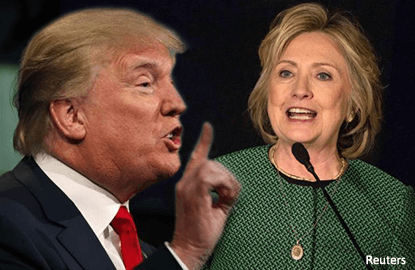
This article first appeared in The Edge Financial Daily, on March 4, 2016.
THE 2016 US presidential election is a circus which will produce an outcome and policies that will tend to fatten labour’s share of the economy, while reducing that of capital.
And yes, that means there may be more emphasis not on growing the pie, but on how it is divvied up, a factor which might possibly depress longer-term growth and would definitely tend to drive profit margins lower.
Super Tuesday is past and now Democrat Hillary Clinton and Republican Donald Trump look to be on rails to their parties’ nominations.
I am assuming Trump loses in a general election, as betting and polling now indicates. If he wins, I wish you the best of luck with your investments. You will need it.
Yet Trump’s rise is significant in a way that goes beyond “where have we gone wrong?” soul searching.

Investors should not so much worry about what President Trump would do, as he likely will not get a chance, but rather take a hard look at the broader underlying forces which might continue to make themselves felt after his candidacy.
Hillary Clinton is being forced left of her natural position by both her primary opponent, Bernie Sanders, and by Trump in a general election. While of course she will run against Trump’s more outrageous positions on, well, everything, she is smart enough and well advised enough that she will grasp that to win she must appeal to the voters whose economic vulnerability Trump exploits.
Sanders, and Elizabeth Warren, have been successful in pushing Clinton to the left in financial services regulation, and given that this too is undergird by Main Street’s sense of being cheated by forces beyond its control, it is likely she will keep going in this direction as she squares off against Trump.
Trump’s positions on immigration and trade, though ranging from wrong-headed to outrageous, are popular, at least in part, because voters in middle- and lower-income groups have seen their share of the pie decline, not for years, but for decades.
Wages and salaries are now 43.8% of gross domestic product, up very slightly from all-time lows in 2010, but still in a long-term downtrend which started above 50% in 1969.
Corporate profit margins have moved in roughly the opposite direction, upward, for roughly the same amount of time and are now not far off of all-time highs.
Globalisation has been great for capital and for people at the very top in the US with the skills to surf its wave. That it has also been good for many in India, Mexico and China who have been lifted out of poverty is not a point which will get much airing between now and November.
What may well get more attention are policies which might protect US jobs, or which might raise US wages, especially in the bottom 80% which globalisation has hurt. Within this context, it may not be a surprise that the US just imposed a 266% tariff on imports of some steel from China, and a lesser range of tariffs on six other countries.
Though I would not expect a trade war from a Clinton administration, it will be keen to be seen to be willing to fight the corner of US wage earners, and perhaps less sensitive to the competing demands of multinational corporations. I cannot imagine a Clinton administration approaching a trade deal in the same corporate-friendly spirit as the Obama White House took to the Trans-Pacific Partnership agreement.
Taxation too will probably be more redistributive than in a world where Trump elected to stay home. Trump’s longest-lasting legacy might be that he leaves Republican economic orthodoxy of low taxes and hope for growth fatally wounded.
These outcomes may be for good or ill, but what they will be is bad for corporate profit margins in aggregate. — Reuters
James Saft is a Reuters columnist. The opinions expressed are his own.